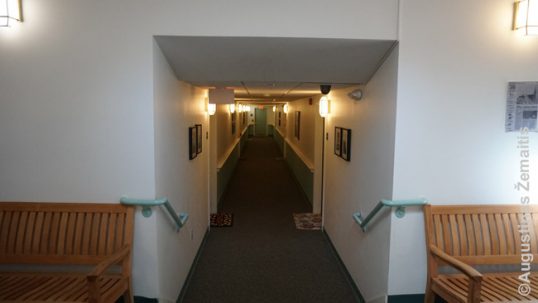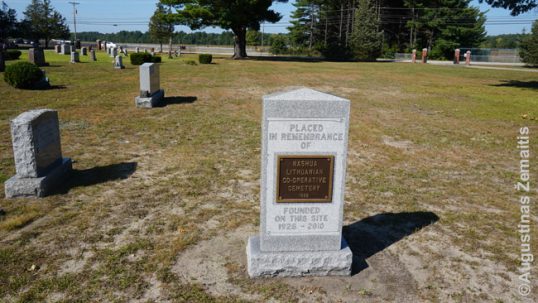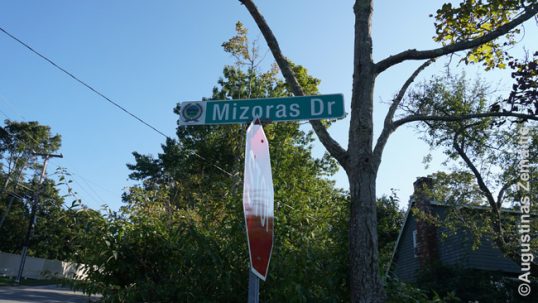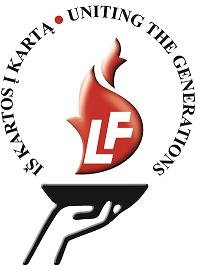New Hampshire
New Hampshire is a small state, it has merely a million inhabitants. However, this region of New England used to be rich and attracted many Lithuanians ~1900; today there are around 7000 of them and the city of Nashua (pop. 85 000) is their heartland, having numerous Lithuania-related sites.
Nashua Lithuanian church
Nashua St. Casimir Lithuanian church (Temple St) was closed in 2002 and converted into apartments which are known as Casimir Place. To the very last day, it served Lithuanian-language mass and had flowers of Lithuanian flag colors surrounding its altar. Inside the former church, there are commemorative plaques about the Lithuanian church and Lithuanians, as well as many old pictures of it. The vault of the Lithuanian church was not destroyed as the attic is left unused; it is still visible through a ceiling glass from the corridor. Entering the church interior may need somebody of those who live there to let you into the building. The gothic revival building itself was not built by Lithuanians but rather acquired from a previous territorial parish that disintegrated into several ethnic parishes.

St, Casimir Lithuanian church of Nashua

The corridor on the second floor built in the church nave. Old images visible here on the walls show the church as it was.
Nashua textile mills
Pre-War Lithuanians (~1000) have been attracted to Nashua by its massive textile industry. Its golden era was short, however, as the Great Depression forced many mills to go bankrupt and the last one closed down in 1949. Some Lithuanians were already too rooted to move away and, therefore, ~700 still live in the city. Unlike many other post-industrial American cities, Nashua enjoyed a true renaissance and was not affected by the White flight. The "Money" magazine twice named it "The best American city to live". Massive textile millswhere the forefathers of local Lithuanians worked at are now considered heritage and may still be explored near the town center (Main St, Franklin St, Factory St).

Nashua factories looking from the spot of "Diversity" statue at Front St (see below)
Nashua Lithuanian cemeteries
Nashua has two Lithuanian cemeteries. The Holy Cross Cemetery in Hudson suburb has the name "Lithuanian" prominently displayed. It was the Catholic cemetery and a flagpole memorial is dedicated to the memory of those who served the country, the community, and the St. Casimir Lithuanian parish. Initially, the Catholic church was reluctant to establish a separate Lithuanian cemetery, but they did so after the Lithuanians who sought their own cemetery established a Lithuanian Co-Operative Cemetery at Carmichal way (~400 graves) in 1928. In those days, cemeteries were a religious issue as the Roman Catholic church insisted that Catholics be buried in the sanctified ground of the Roman Catholic cemeteries. However, some Catholics actually preferred cemeteries based on the ethnicity. After understanding that the religious dogma alone will not stop the establishment of the Lithuanian ethnicity-based cemetery in Nashua, the Catholic church also established a separate Catholic cemetery for Lithuanians.

Holy Cross Lithuanian cemetery with the Lithuanian and American flags
Therefore, while beforehand there had been a dispute if Lithuanians need a separate cemetery at all, currently two Lithuanian cemeteries operate. The Co-Operative cemetery, however, has since been renamed "Pinewood cemetery" (in 2010), but its history is still reminded by a memorial. Only the American and New Hampshire flags wave there though. Like the Holy Cross Cemetery, it has many old Lithuanian graves.

A memorial commemorating the Lithuanian Co-operative cemetery
Nashua Lithuanian sculptures and streetnames
Unlike many of the so-called Lithuanian "colonies" of the pre-war first wave, Nashua continued to have substantial Lithuania-related activities after the church closure. A major reason for that is the Zylonis fund, created by a will of a Nashua Lithuanian in the 1970s. Its money is to be used to strengthen the Nashua-Lithuanian relations, attracting, for example, Lithuanian bands to concert ant Nashua. Nashua library too has Lithuanian books and hosts some Lithuanian events. Some Lithuania-related places have been funded by the Zylonis Fund as well, including the sculpture "Talking Bush" by a Lithuanian sculptor Asta Vasiliauskaitė (E Hollis St) - the sculpture has no Lithuanian details, but the old age of the Lithuanian language is explained next to it (the plaque also cites the author: "I am pleased that many Lithuanians have found happiness in Nashua and in the United States. When a person is happy, he shines from the inside"). Another sculpture by Lithuanians is Diversity next to where the factories are, created by the Nashua Lithuanians Woitkowski and Tomolonis.

Talking Bush statue by Vasiliauskaitė
Nashua has multiple locations named after their former Lithuanian owners. One of them is the Gelazauskas preserve west of the town, located on the land sold to the public authorities at under-market rates (200 000 instead of 2 800 000 USD) by the Gelažauskas family (while most Lithuanians came to New Hampshire to work at the factories, some, like Gelažauskas, eventually acquired land for farming, as land was always important in the Lithuanian culture; before World War 2, many Lithuanians saw industrial jobs only as means to earn money to buy land for farming, often back in the still-70%-rural Lithuania; Gelažauskas family had a dairy farm on that land). A wooden plaque with its name marks the entrance to the preserve.

Gelazauskas preserve entrance
Another area with multiple Lithuanian placenames is a collection of Lithuanian-named streets after the members of a single family who lived there. Now the streets have detached homes. The names are Tomolonis, Vieckis, Mizoras, Monica, and Monias (the last two anglicized Lithuanian, the first three originals). The original owners of the farm there were Leon Vieckis and Monica Mizuras; their daughter Monica then married another Lithuanian Joseph Tomolonis, while their daughter Phyllis married Frank Monis.

Mizoras Drive, one of the Nashua Lithuanian-named streets
Elsewhere, there is also Vilna street in Nashua, named after Vilnius (its old Russian name, still popular in English before World War 1 when most of the Nashua Lithuanians moved in). There is also Grigas street next to the Holy Cross Lithuanian Cemetery.
New Hampshire Lithuanian sites outside Nashua
Manchester city north of Nashua has a small street named after Lithuanian city of Kaunas (Kaunas Circle). Manchester's mile-long rows of former textile mills survive around Commercial St and are in good shape. The local Millyard Museum explains how they operated and how the immigrants (including Lithuanians) worked there.
After World War 2, a group of Lithuanian Benedictine nuns who had fled the Soviet-occupied Lithuania established their small convent in Bedford (a suburb of Manchester). This convent operated since 1957 to 1999, although after the 1990 independence of Lithuania, the sisters have relocated their activities back to Kaunas, Lithuania. After the closure and the Bedford convent, Benedictines sold the land to public use. The original convent burned down and new owners have transformed the land into a park which is known as Benedictine Park but nothing otherwise Lithuanian remains there. However, with the closure of the convent, land was acquired in the St. Joseph cemetery and a Lithuanian Benedictine memorial constructed there. The memorial includes names of the nuns, a traditional chapel-post symbol and a short story behind the convent.

Lithuanian Benedictine Memorial in the cemetery (image provided by Lithuanian Benedictines)
Epping may lack a Lithuanian community but it has a famous grave: that of Jack Sharkey, a heavyweight world champion of boxing. He was a pure Lithuanian: “Jack Sharkey” was just a pseudonym based on the names of his favorite boxers, while his original name was Juozapas Žukauskas. Today, he is among the best-known people among the Lithuanian-Americans.

Jack Sharkey (Juozapas Žukauskas) grave in Epping
Map of the Lithuanian sites
Map of Merrimack Valley Lithuanian sites
Share this:
Map of Lithuanian heritage in New England


Map of the Lithuanian heritage in New England (Connectictut, Massachusetts, Maine, Rhode Island, New Hampshire) and Quebec.
More info on Lithuanian heritage in Connecticut, Maine, Massachusetts, New Hampshire,
Rhode Island, Quebec.
Share this:
Language
True Lithuania services
Sister websites
True Lithuania – Extensive website on Lithuania, its culture, cities, history and more
Our Youtube – English videos on Lithuania and interviews with Lithuanians abroad
Destination Lithuanian America – Map of 800+ Lithuanian heritage sites in the USA and Canada
Comments
- Lisa Lapin on New Hampshire
- Reece Lyons on
- Bob Reich on Pittsburgh, Pennsylvania
- Telkom University on Philippines
- Telkom University on Vancouver, British Columbia
Donations
Advertisement
Youtube
Info
- Destination Lithuanian America
- Differences between Lithuanians and neighboring nations
- Divine Mercy: Lithuanian-originated Christian tradition
- Foreign locations named after Lithuania
- Grand Duchy of Lithuania castles abroad
- How to save Lithuanian-American heritage
- Lithuanian camps
- Lithuanian cemeteries abroad
- Lithuanian Churches Abroad
- Lithuanian Convents abroad
- Lithuanian diaspora cuisine
- Lithuanian districts abroad
- Lithuanian Halls abroad
- Lithuanian heritage abroad: what is it?
- Lithuanian minority heritage abroad
- Lithuanian museums abroad
- Lithuanian Schools abroad
- Maps of Lithuanian heritage abroad
- Similarities between Lithuanians and other nations
- Website author Augustinas Žemaitis
- Top Lithuanian locations outside Lithuania
- Lithuanian streets and monuments outside Lithuania
Topics
Andrew / Kunta Kinte island Bar Do Vito Sao Paulo Gardinas Palaces Golshiany Palace Grodno Palaces Kengyr Gulag uprising monument Kosava Palace Krėva / Krevo Palace Lida (Lyda) Castle Lida Palace Lithuanian chapel of Washington National Shrine Lithuanian colonies in Africa Lithuanian colony in Gambia Lithuanian consulate general in Latin America Lithuanian district of Sao Paulo Lithuanian embassy in the USA Lithuanian embassy to the European Union Lithuanian Martyrs chapel in Rome Lithuanian migration to Brazil Lithuanian migration to Uruguay Lithuanian shopping malls in Georgia Lithuanians in Bayonne (New Jersey) Lithuanians in Brazil Lithuanians in Jersey City Lithuanians in Kearny (New Jersey) Lithuanians in St. Lawrence (Verano) cemetary Lithuanian Uruguayan cultural society Lituanica (Lithuania) square in New York City Minnesota Lithuanian community Mir (Myras) Castle Navahrudak (Naugardukas) Castle Nesvizh (Nesvyžius) Palace New Jersey St. Paul and St. Peter Lithuanian church Our Lady of Vilnius chapel in Rome Peshchenlag Lithuanian prisoners monument Ruzhany (Ružanai) Palace St. Michael Lithuanian church Bayonne Steplag Lithuanian prisoners monument Transfiguration church in Brooklyn Transfiguration church in Queens Vila Zelina in Sao Paulo Villa Lituania in Rome Vilnius square in Tbilisi (Georgia) Vilnius University model in Mini-Europe park (Brussels) Wilno village in MinnesotaMain sponsors this year:


Department of Cultural Heritage of Lithuania


Lithuanian Foundation, Inc.


Press, Radio, and TV Support Fund of Lithuania


